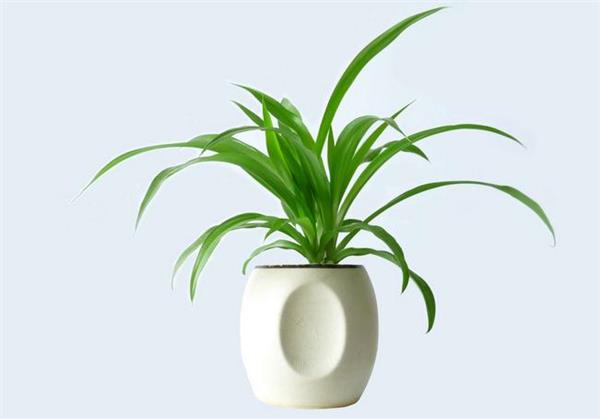How much do you know about the maintenance method of spider orchid
Many friends will put a pot of orchids indoors, so that they can play a role in purifying the air. So, how much do you know about the maintenance methods of hanging orchids? Today, let's give you a brief introduction. Let's take a look at it.

The living habits of Cymbidium
Hanging orchid, commonly known as weeping grass, originated in Africa, is now cultivated all over the world, and Europeans call it spider grass or airplane grass. The most important feature of Cymbidium is that the mature plants will grow new stems from time to time, and the new stems will grow into small plants. it likes the warm, humid and semi-shady growth environment, and is suitable for long-term indoor cultivation. The flowers and colors of hanging orchids are mainly white, with several flowers in a cluster, which looks clear and pleasant and has high ornamental value.

Types of hanging orchids
1. Broad-leaf orchid: the leaf is broadly linear, entire or slightly wrinkled. The scape is extracted from the leaves and forms a creeping stem after flowering, which can take root and sprout and grow into a new plant. Raceme, white flowers, 2 flowers per bract axil, perianth two whorls, 6 pieces. Flowering in spring and summer, capsule three prismatic globose.
2, silver heart orchid, also known as the middle spot hanging orchid: the leaf is narrow and long, lanceolate, milky white with green stripes and edges.
3. Milky white orchid: the main vein of the leaf has a white longitudinal pattern.
4. Purple orchid, also known as colored leaf orchid: the main vein of the leaf is purple.
5. Phnom Penh orchid: the edge of the leaf is golden, the leaf is slender and soft, the leaf hangs like a flower, it is evergreen all the year round, and it is known as "folding crane orchid" in ancient times. Its special shape constitutes a unique hanging landscape and three-dimensional beauty, which can play a chic embellishment effect.
6. Magnolia: evergreen perennial herb, slender leaves, linear lanceolate, yellow-white longitudinal stripes in the center, bright green. It is a common office and home potted plant.
7. Silver-edged hanging orchid: the leaf edge of silver-edged orchid is white.
8. Magnolia: there are silver-white longitudinal stripes around the main vein of the leaf.

Maintenance method of hanging orchid
1. Suitable lighting: the hanging orchid likes the semi-shady environment, and the hanging orchid is very sensitive to the light. if the summer and autumn sunlight is direct, the leaves will wither and yellow, or even the whole plant will die, so it should be kept in a cool and ventilated place, and pay attention to maintaining the humidity of the environment. At most, you can only see some oblique light sooner or later. In winter, because the sun is not strong, we can let the orchid accept some direct sunlight properly.
2. Fertilization: Cymbidium is a more fertilizer-tolerant plant. If there is not enough fertilizer and water, it is easy for the scorched head to grow old, the leaves turn yellow and lose ornamental value. For Cymbidium which has begun to grow plantlets, nitrogen topdressing can be applied once every half a month. If the orchid grows well, it can be done without fertilization.
3. Change the soil and change the basin: the culture of Cymbidium usually changes the basin every 2-3 years, but in the specific maintenance, in order to make the stems and leaves flourish, the soil and basin can be changed in March every year.
4. Pest control: pest and disease are not easy to occur in Cymbidium culture. The occurrence of the disease is generally caused by stagnant water in the basin soil and poor ventilation, so it should be prevented and treated in time.
5. Pruning: in the aspect of pruning, the yellow leaves should be cut off at any time at ordinary times, and the basin can be turned once every March to cut off the old root, rotten root and excess fibrous root. The old leaves of Cymbidium can be cut off in the first and middle of May, which will promote the germination of more new leaves and small Cymbidium.

This is the end of the relevant introduction to the maintenance methods of the hanging orchid. I believe that after reading it, we have a certain understanding of the hanging orchid. If there are friends who want to raise orchids indoors, you can refer to the relevant knowledge points that I introduce to you.
Related
- Wuhan Hospital Iron Tree Blooming Result Was Instantly Frightened by the Gardener Master
- Which variety of camellia is the most fragrant and best? Which one do you like best?
- What is the small blue coat, the breeding methods and matters needing attention of the succulent plant
- Dormancy time and maintenance management of succulent plants during dormancy
- Minas succulent how to raise, Minas succulent plant pictures
- What are the varieties of winter succulent plants
- How to raise succulent plants in twelve rolls? let's take a look at some experience of breeding twelve rolls.
- Attention should be paid to water control for succulent plants during dormant period (winter and summer)
- Watering experience of twelve rolls of succulent plants
- Techniques for fertilizing succulent plants. An article will let you know how to fertilize succulent plants.



